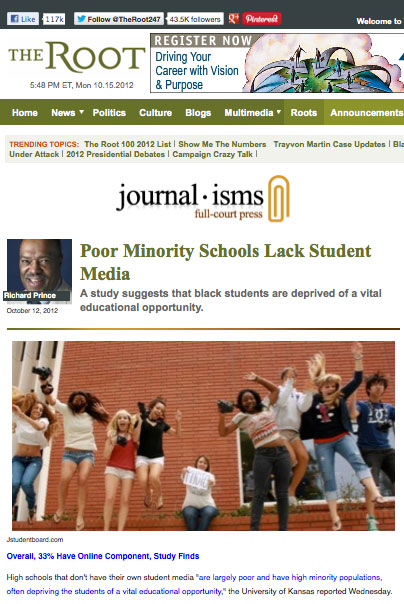by Julie Dodd
JEA Mentoring Committee co-chair
 I was interested in this blog post about high school media by Richard Prince on The Root. Prince comments on the study done by Peter Bobkowski, Mark Goodman and Candace Perkins Bowen that found poor minority schools lack student media.
I was interested in this blog post about high school media by Richard Prince on The Root. Prince comments on the study done by Peter Bobkowski, Mark Goodman and Candace Perkins Bowen that found poor minority schools lack student media.
“Schools that reported having no student media had an average of 54 percent of students who qualified for free or reduced price lunch, compared to 41 percent in schools that do. The average school without student media had a 56 percent minority population compared to 35 percent of schools with media.”
Those findings are based on a survey of more than 1,000 high schools in all 50 states and the District of Columbia.
Prince talks about the importance of providing all students with the opportunity to experience student media. Getting minority students involved in student media, he says, is important, in part, because that increases the likelihood that those students will continue on into media careers — thus making the media workforce more diverse.
Those of us who are sold on the value of high school media are glad to see this research published in Journalism & Mass Communication Education’s September 2012 issue and receive coverage outside the academy, such as Prince’s blog post. This research helps college educators and those in the media realize the importance of supporting high school media.
The JEA Mentoring Program has as a goal promoting diversity in student media. In some cases, that’s meant starting or restarting student media in low-income and/or majority minority schools. For several years, the program had funding from the Newspaper Association of America (NAA) Foundation and from Sandy Woodcock. In budget cuts, NAAF cut its funding for the program.
The JEA Mentoring Program also works with advisers to promote both the recruitment of minority for student media staffs and the representation of a diversity of voices in the student media itself. The program’s efforts support JEA’s goal of promoting diversity in student media.
Peter, Mark and Candace are long-term advocates of scholastic journalism — and all three regular attenders of JEA/NSPA conventions.
I first met Peter at a JEA/NSPA convention in a technology session. He was a high school adviser in Texas at the time. Since then, he has earned a doctorate at the University of North Carolina and worked with Monica Hill and the North Carolina Scholastic Media Association. Peter now is on the faculty at the University of Kansas.
Mark Goodman was the executive director of the Student Press Law Center for 22 years. He now is the Knight Chair of Scholastic Journalism at Kent State University.
Candace Perkins Bowen is a faculty member at Kent State, the director of the Northeast Ohio Scholastic Press Association, and director of Kent State’s Center for Scholastic Journalism. She is a former Dow Jones Newspaper Fund Journalism Teacher of the year and a former JEA president and was a member of the original JEA Mentoring Committee.
We’re fortunate to have colleagues in higher ed who value high school journalism and are involved in research that helps others see the importance of high school media.
